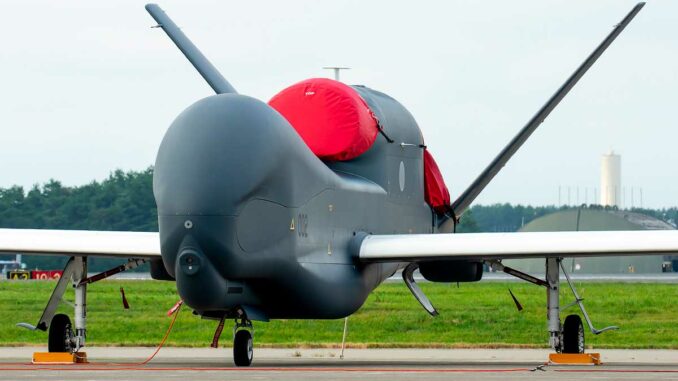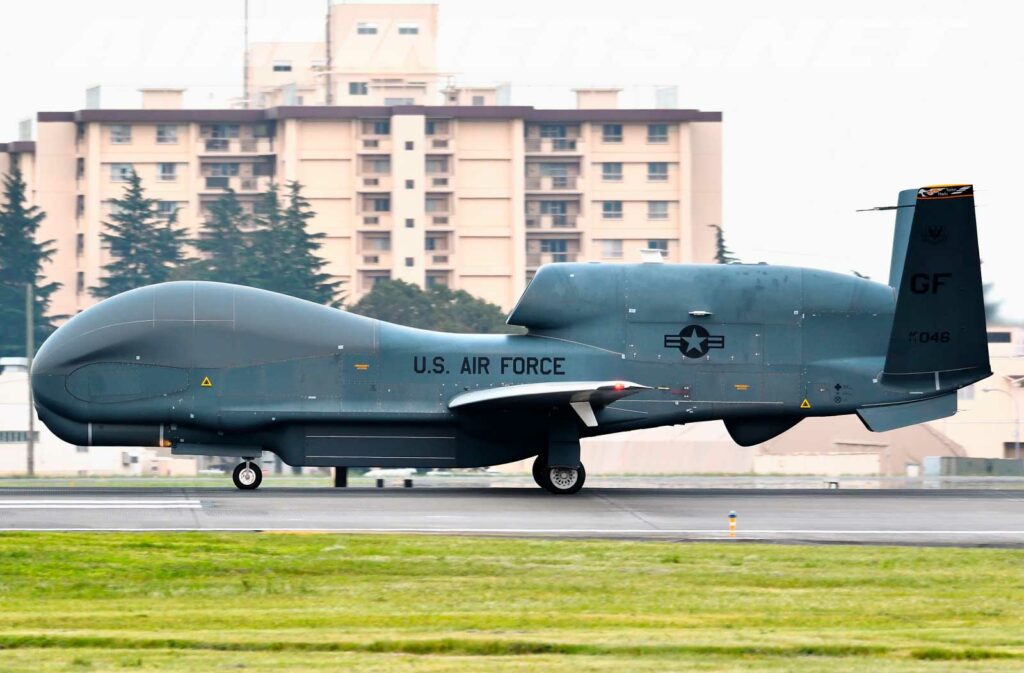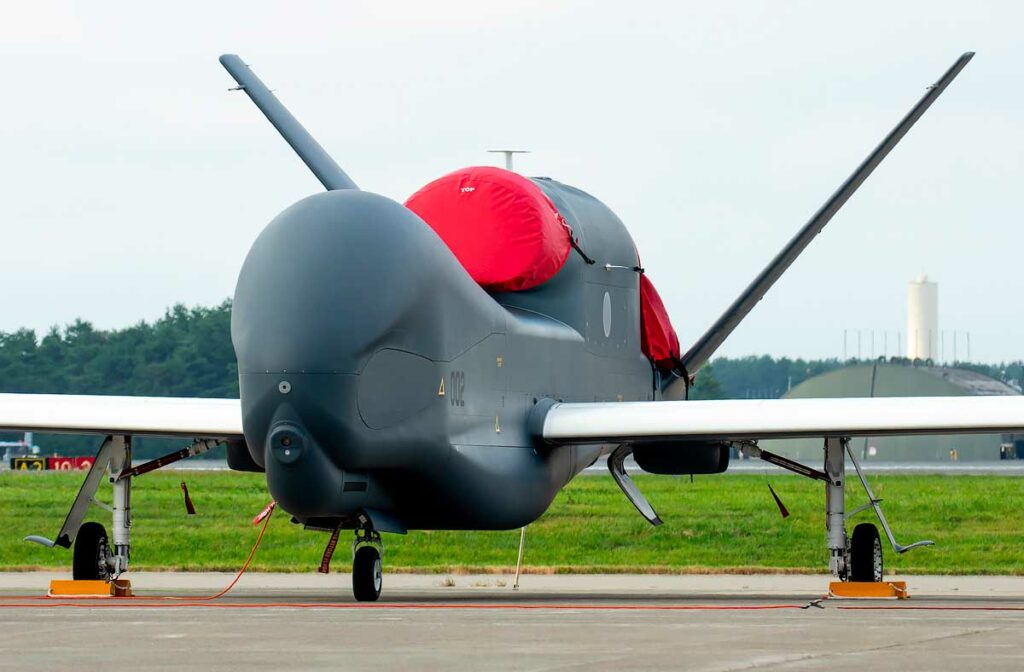
A US Air Force RQ-4B Global Hawk drone has resumed reconnaissance flights over the Black Sea from the Sigonella base.
On May 17, 2025, the US Air Force resumed strategic reconnaissance flights over the Black Sea with an RQ-4B Global Hawk drone after several months of interruption. The drone, identified as FORTE 10, operated from the Sigonella base in Sicily, flying over the Romanian coast. This resumption marks a change in the US posture in the region, after a period of activity mainly carried out by British and French forces. The Global Hawk, capable of remaining in flight for more than 30 hours at high altitude, is a major asset for ISR (intelligence, surveillance, reconnaissance) missions. This activity is also accompanied by US naval operations, including flights by the P-8A Poseidon near Russian waters.

Resumption of strategic flights in sensitive airspace
The Northrop Grumman RQ-4B Global Hawk, a US Air Force strategic surveillance drone, was observed on May 17 in international airspace off the coast of Romania as part of an ISR mission over the Black Sea. Its departure from the Sigonella base in Sicily confirms that the United States is reactivating its strategic air presence in the area after a prolonged suspension of drone flights in the sector.
This type of mission was daily between 2022 and 2024, but was suspended after Donald Trump returned to the presidency. During this hiatus, it was mainly the air forces of the United Kingdom and France that gathered intelligence on Russian movements in the Black Sea.
The resumption of these missions by the United States suggests a doctrinal or political adjustment in the context of deteriorating relations with Russia and an increased need for intelligence on military activities around Crimea and southern Ukraine.
The capabilities of the RQ-4B Global Hawk: an endurance ISR platform
The RQ-4B Global Hawk is a high-altitude, long-endurance reconnaissance drone designed for strategic missions at altitudes above 20,000 meters. It is equipped with a suite of integrated sensors enabling:
- electro-optical and infrared surveillance day and night,
- synthetic aperture radar (SAR) imaging,
- ground reconnaissance capability over more than 100,000 km² per flight,
- flight endurance of more than 30 hours, with a cruising speed of approximately 570 km/h.
The aircraft can carry out missions without interruption over several conflict zones simultaneously, making it strategic for tracking troop movements, ships, or military equipment.
It operates exclusively in international airspace, but can cover the entire Black Sea coastline, from Constanța to Novorossiysk, and even beyond. Its payload exceeds 1,300 kg, consisting exclusively of sensors and real-time data transmission equipment for allied command centers.
Coordinated air presence with the US Navy
This return of drones is part of a broader restructuring of the US presence in the region. In early May 2025, a P-8A Poseidon maritime patrol aircraft belonging to the US Navy was detected near the port of Novorossiysk, one of the main anchorages of the Russian Black Sea Fleet.
The P-8A Poseidon, a military version of the Boeing 737, is equipped with AN/APS-137D(V)5 radar, capable of detecting an aircraft carrier or large ship at a distance of more than 450 km. It can also:
- track submarines diving at shallow depths using acoustic buoys,
- deploy MK 54 light torpedoes,
- and transmit information live to NATO’s C4ISR network.
The integration of these assets — strategic ISR drones and anti-submarine maritime patrol aircraft — constitutes a multi-domain approach designed to:
- observe Russian military movements in southern Ukraine,
- secure naval approaches in the Black Sea,
- and respond to hybrid or asymmetric threats in the region.

Russian reactions and risks of escalation
Western air activity in the Black Sea is regularly challenged by Russian forces, which carry out interceptions or attempts at electronic jamming in areas close to Crimea. Several notable incidents have taken place:
- In March 2023, a Russian Su-27 collided with a US MQ-9 Reaper, causing it to crash into the Black Sea.
- Russian aircraft sometimes fly over ISR flight zones at a distance of less than 30 meters, increasing the risk of incidents.
Despite this, NATO aircraft strictly respect international airspace, in accordance with the Chicago conventions on civil and military aviation. Nevertheless, ISR reconnaissance flights are considered by Moscow to be hostile or provocative acts, particularly when aircraft fly over areas close to the Russian coastline.
The resumption of RQ-4B flights could therefore rekindle diplomatic tensions, especially since the imaging and transmission capabilities of this drone are perceived as a direct threat to Russian military installations.
A strategic repositioning by the US around the Black Sea
The return of the Global Hawk drone to the skies over the Black Sea signals a change in the US’s strategic positioning after a period of relative withdrawal under the Trump administration. It marks:
- an affirmation of the US’s advanced intelligence posture in Eastern Europe,
- a desire to better anticipate Russian military movements,
- and closer coordination with NATO forces in the area.
The Sigonella air base, the departure point for the FORTE 10 flight, is at the heart of this operation. It is home to:
- MQ-9 Reapers,
- P-8A Poseidons,
- and now RQ-4B Global Hawks assigned to strategic ISR missions in Europe, North Africa, and the Middle East.
This renewed activity is also part of a broader doctrine of military containment in response to gray areas of confrontation where conventional forces cannot intervene directly.
War Wings Daily is an independant magazine.